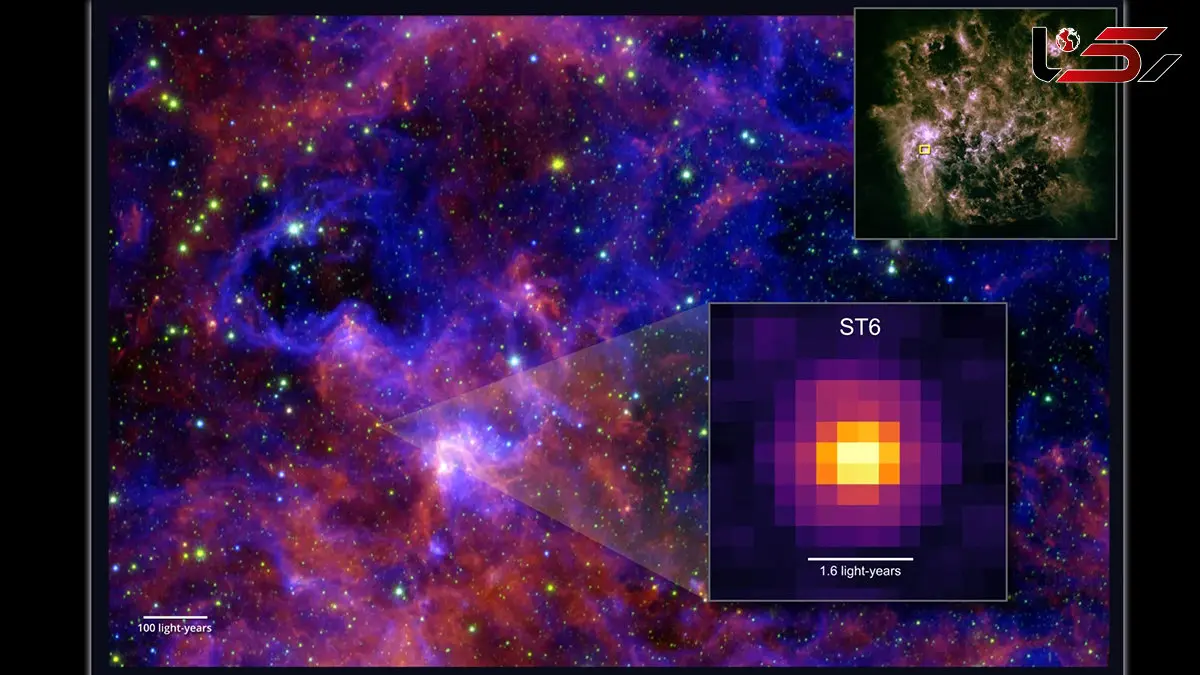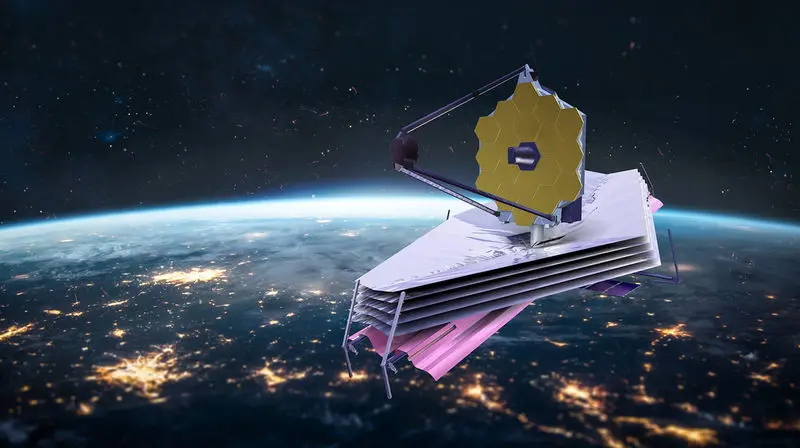JWST makes key detection of complex organic molecules around star in galaxy beyond our Milky Way
Rokna Social Desk: Astronomers using the James Webb Space Telescope have, for the first time, detected frozen complex organic molecules encasing dust grains around a young protostar outside the Milky Way, offering unprecedented insight into the early chemical pathways that may give rise to the building blocks of life in distant galaxies.

The location of the massive protostar ST6 in the star-forming region N158, close to the giant Tarantula Nebula (30 Doradus) in the Large Magellanic Cloud. The protostar still exists in a huge core of gas 1.6 light-years across. Inset is a view of the LMC seen in infrared. (Image credit: NASA/ESA/CSA/JPL-Caltech/M. Sewiło et al. (2025))
Frozen complex organic molecules have been discovered for the first time as ices around a young protostar in a galaxy other than our own, thanks to the observing power of the James Webb Space Telescope (JWST).
Astronomers led by Marta Sewiło of the University of Maryland used the JWST's Mid-Infrared Instrument (MIRI) to detect myriad complex organic molecules (COMs) in ice that encase grains of dust around the massive protostar ST6 in the Large Magellanic Cloud (LMC), which is a neighboring dwarf galaxy about 163,000 light years away. COMs are classed as carbon-bearing molecules containing more than six atoms, and many COMs are the chemical precursors to the building blocks of life as we know it.
Zoom into a 'dust trap' around a distant star in this simulation
A simulation shows dust swirling around the star IRS 48 where the complex molecules needed for life could arise. Credit: ESO
0 seconds of 0 secondsVolume 0%
Press shift question mark to access a list of keyboard shortcuts
Saturn's moon Enceladus: Fresh ice indicated in new infrared views
01:09
Loading ad
00:25
00:00
00:54
PLAY SOUND
At least 14 other absorption lines were also detected by JWST, but so far Sewiło and her colleagues have been unable to confirm their identity.
"We have only just started exploring the dependence of complex organic chemistry on the environment," Sewiło told Space.com in an interview.
Breaking space news, the latest updates on rocket launches, skywatching events and more!
JWST is breaking new ground in the study of chemistry in environments where stars and, later, planets form.
Stars form when massive clouds of frigid molecular gas begin to fragment and collapse, producing dense cores where stars begin to coalesce. At first, these cores are cold, less than 100 kelvin (i.e., 100 degrees above absolute zero) and complex molecules exist as ices on dust grains. It is only later, when the core grows hotter, that the ice sublimates and releases the COMs as gases.
Whereas COMs in their gas phase have been detected multiple times around young stars in both the Milky Way galaxy and the LMC — for example, both methanol and methyl formate had previously been found in their gas phase around protostars in the LMC — they have been far harder to spot when in the earlier, cold ice phase.
"JWST has enabled the detection of COM ices, but to date there are only four protostars in the Milky Way where we have detected icy COMs, and only one in the LMC — ST6," said Sewiło.
By detecting the COMs in their frozen states, astronomers get an indication of how far evolved the chemistry of the material surrounding protostars is at the earliest stages of star formation.
Their presence around a young, massive protostar in the LMC is also intriguing, given the differing conditions there compared to our Milky Way galaxy. The LMC has properties in common with galaxies that existed when the universe was much younger, namely a lower abundance of elements heavier than hydrogen and helium and a stronger ultraviolet radiation field. The lack of heavy elements could impact the abundance of COMs, while the ultraviolet radiation could affect the rate of chemical reactions.
Therefore, understanding the organic chemistry of the LMC can also help teach us about the organic chemistry of the early universe, in particular how soon the building blocks of life were able to form. This could help place limits on how early, theoretically, life could have formed in the universe.
The dearth of heavy elements in the LMC does seem to have impacted the abundance of COMs around ST6.

Complex organic molecules have been identified in the icy mantle on dust grains around the protostar ST6 in the Large Magellanic Cloud. (Image credit: NASA’s Goddard Space Flight Center)
"The COM ice abundances with respect to water ice that we measured for ST6 are lower than those measured for the four protostars in the Milky Way for all COMs, as expected, except for acetic acid," said Sewiło. "The overabundance of acetic-acid ice is likely the result of the higher ultraviolet flux in the LMC."
Among the unknown absorption lines in ST6's spectrum could be glycolaldehyde, which is a chemical precursor to ribose, which is a component of RNA molecules.
"We have found evidence that several of the unidentified absorption features could be attributed to glycolaldehyde, but the detection remains inconclusive since more laboratory spectra are needed to verify it," said Sewiło, alluding to the fact that the star's spectrum is compared to those of different molecules taken in laboratory conditions to identify which absorption lines belong to which COMs.
"It is likely that more COMs are present in the ices around ST6, and our results highlight the need for more laboratory experiments."
As the protostar evolves and heats up, the ice on the dust grains nearest the star will sublimate and the COMs will move into their gas phase, as has previously been detected.
It is in the gas phase that more chemical reactions can take place, triggered by ultraviolet radiation from the protostar and the wider environment, "leading to larger and more complex molecules important for life such as propanol and propanal, and possibly amino acids, but we've not detected them in ST6 yet," said Sewiło.
Amino acids have, however, been found in comets and meteorites in our solar system. Comets and meteorites are ancient bodies, formed 4.5 billion years ago when our sun was a protostar. The implication is that amino acids are the end result of a pathway of chemical reactions that begin with the kinds of COMs discovered around ST6.
The research was published on Oct. 20 in Astrophysical Journal Letters.
Correction 11/10: COMs have been seen in other galaxies before — this is the first time they've been detected as ices. The absorption lines referred to in the article may also not necessarily indicate 14 different molecules. This article has been updated to reflect that.

NASA
Question 1
Which launch vehicle carried the James Webb Space Telescope into space?
SpaceX Falcon Heavy
United Launch Alliance Atlas V
Arianespace Ariane 5
ESA Vega-C
NASA
Question 2
When was the James Webb Space Telescope launched?
December 25, 2021
December 25, 2020
January 1, 2022
July 11, 2022
NASA
Question 3
What is the diameter of the primary mirror on the James Webb Space Telescope?
2.4 meters (7.8 feet)
6.5 meters (21.3 feet)
10 meters (32.8 feet)
21.3 meters (69.8 feet)
NASA
Question 4
How many mirror segments make up the primary mirror?
18
14
7
5
NASA
Question 5
What technology protects the James Webb Space Telescope from sunlight and keeps it cool?
A cryogenic cooling system
Solar array
Radiator panels
Five-layered sunshield
NASA
Question 6
What type of light is the James Webb Space Telescope optimized to observe?
Radio waves
Visible light only
Visible and ultraviolet light (UV)
Infrared and near-infrared
NASA
Question 7
How far back in time can the James Webb Space Telescope observe?
Up to 10 billion years
Up to 13.8 billion years, the time of the Big Bang
Up to 1 billion years
Up to 9.7 billion years
NASA
Question 8
How much did the James Webb Space Telescope cost?
$10 million
$500 million
$3.5 billion
$10 billion
NASA
Question 9
Why is the James Webb Space Telescope considered the successor to the Hubble Space Telescope?
It is cheaper
It observes primarily in visible light
It carries the same style of instruments
It offers deeper infrared views and larger mirror capabilities
NASA
Question 10
Where is the James Webb Space Telescope currently located?
Low-Earth orbit
Geostationary orbit
Sun-Earth Lagrange point 1 (L1)
Sun-Earth Lagrange point 2 (L2)
0:00
Your score
0/10
Infrared and informed: The ultimate James Webb Space Telescope quiz
Browse more quizzes
Tip: Use the hint button if you're stuck!
Send Comments